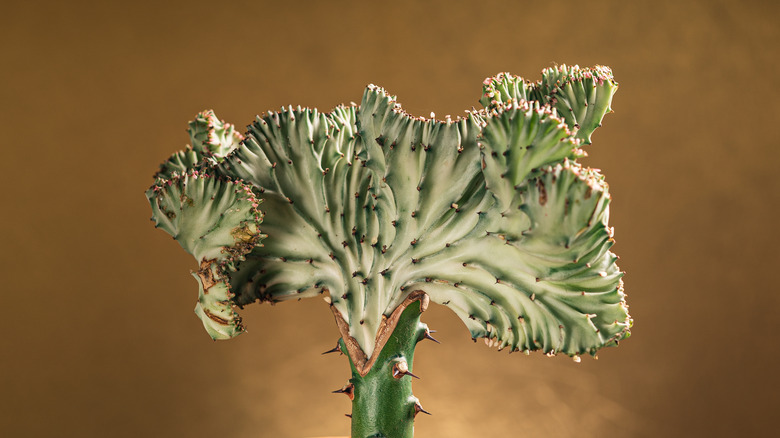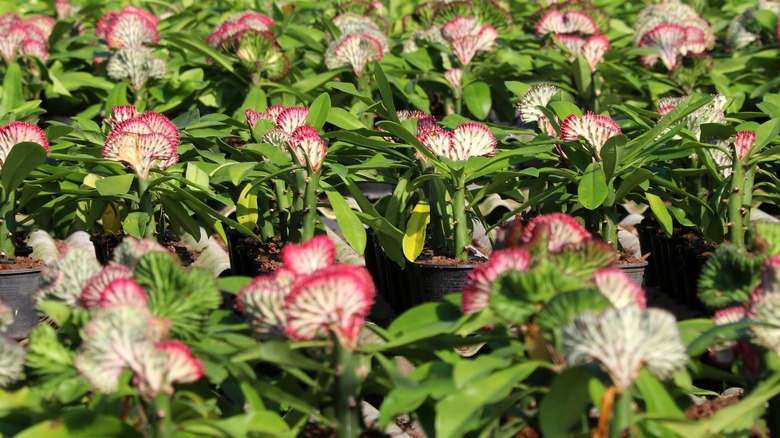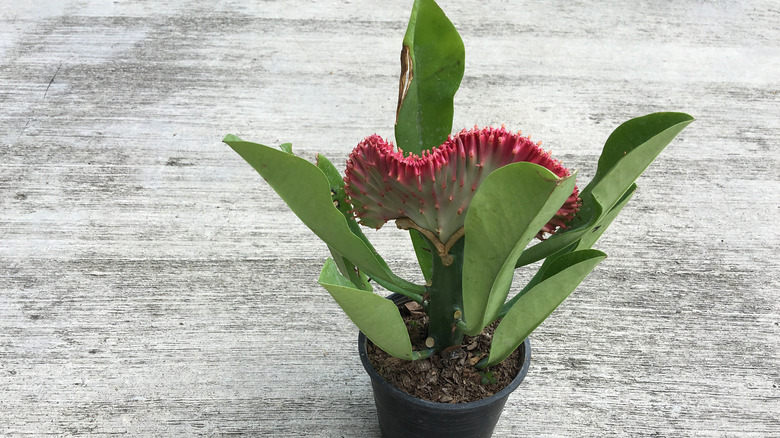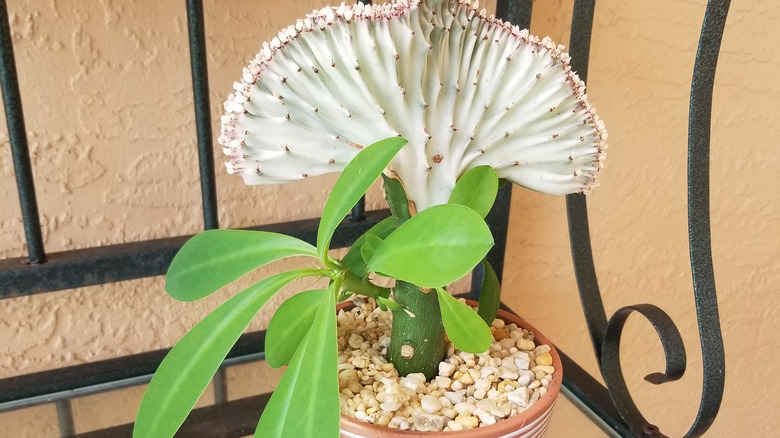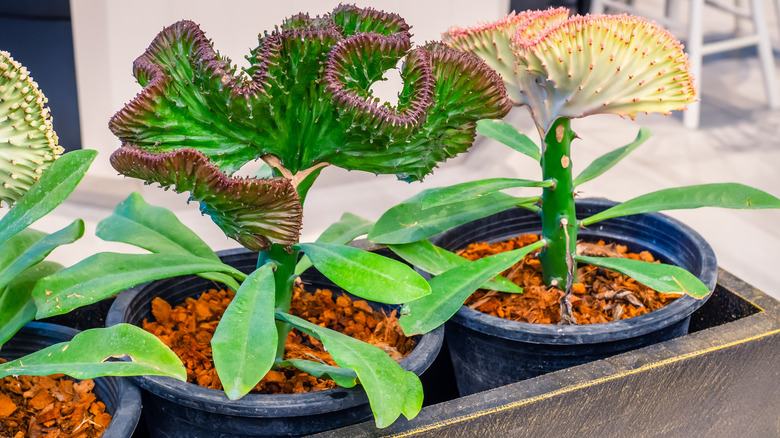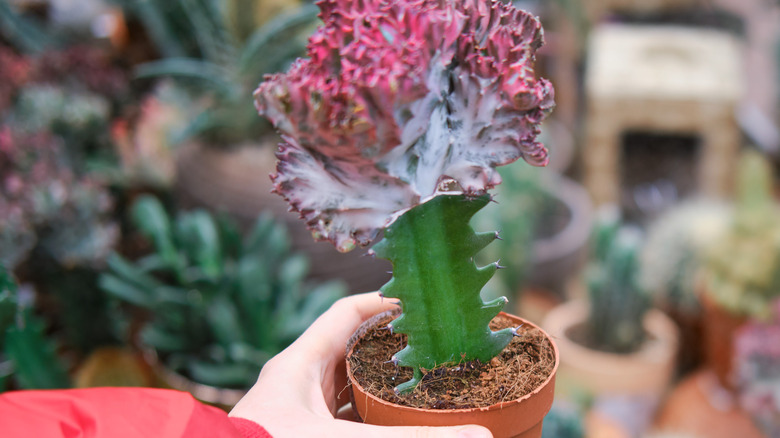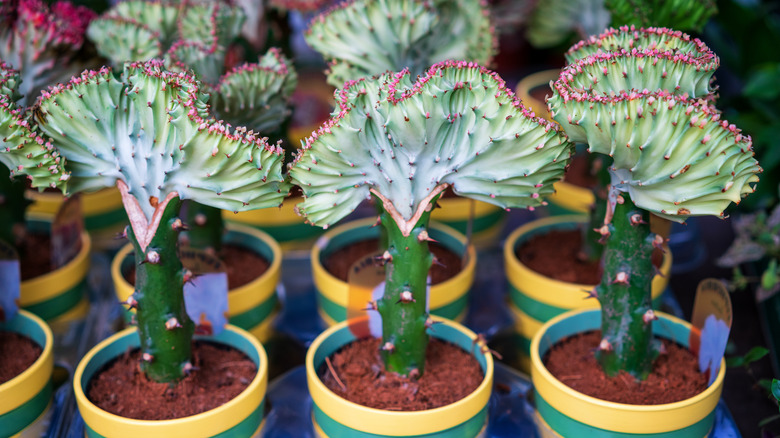How To Care For A Crested Cactus
If you are in search of a succulent plant that is easy to maintain and hardy in the same measure, you should consider the crested cactus. Also referred to as the crested Euphorbia or by its scientific name, Euphorbia lactea 'Cristata', it is a small plant with a structure that splays out to look like a fan. Green is the most common color, but the plant also comes in colors such as blue-gray or silver. With such a unique structure and color variations, the plant is prized for its ornamental value. In fact, it is highly sought-after among plant collectors for its rarer qualities.
It is essential, however, to clarify that the crested cactus is actually classified as a succulent, despite its misleading name. Sublime Succulents explains that although every cactus is considered a succulent, the opposite is not true. In light of that, let's get you up to speed on everything you need to know if you are considering adding this plant to your home or garden.
How to use a crested cactus in garden
Although not a true cactus, the crested cactus definitely resembles them well enough to confuse even experienced gardeners. They are typically grown in pots as houseplants, but that doesn't mean they're not also suitable for your outdoor garden. It's important to note that these plants rarely bloom, but often their coloring is bright enough to stand out in even a crowded garden. Still, it might be nice to compliment your crested cactus by planting it alongside some equally vibrant flowering plants. Avoid anything too tall, however, as crested cacti tend to remain on the smaller side.
The crested cactus is more commonly grown indoors likely in part because it can be better showcased when standing alone in its own pot. This also ensures it is protected from harsh conditions or accidental destruction by children and pets running freely throughout your yard. As NatureHills.com, explains, interest in unique specimens such as the crested cactus has only grown among novice gardeners and experienced plant lovers alike. The unusual rippling shape of this plant immediately draws attention and is placed to best celebrate its unique, organic beauty.
How to grow a crested cactus
As previously mentioned, the crested cactus plant is quite easy to grow and care for. They do require a good degree of care and attention during the early stages of growth, but from that point on and throughout the majority of their life cycle, they are largely self-sufficient. Though they are considered hardy species, crested cacti don't do particularly well in the cold. If you happen to live in a region where temperatures can plummet below freezing, it is best to plan to move any outdoor pots indoors over the winter, per Succulents and Sunshine.
Propagation is rather difficult, but it can be achieved by grafting into either a mature Euphorbia canariensissince or Euphorbia neriifolia plant. This is because the plant hardly flowers and thus rarely produces seeds. Sublime Succulents recommends attempting to graft in the summer, during the crested cactus's peak growing time. If you're up for the challenge, use a sharp, sterilized knife to make a v-shaped slit at the top of the base plant, already rooted in the soil. Next, cut the bottom of the crested cactus stem into a matching arrow shape. Join the two plants together like puzzle pieces and hold them in place with string or a strip of cling wrap. Place the newly-grafted plant in the sunshine, but avoid harsh temperatures during this delicate time. Allow the plant to grow for a couple of weeks before transferring it to a more permanent location.
How to care for a crested cactus
If you've managed to successfully graft a crested cactus, rest assured that the hardest part has now passed. This plant requires little care to keep it healthy, making it an ideal houseplant for first-time gardeners. The crested cactus thrives in bright, indirect sunlight. If you choose to grow this plant outdoors, make sure it is provided with some cover from direct sun. As suggested by Plant Care Today, a good place to grow the crested cactus would be under a tree with enough shade.
As a succulent able to store water, this plant does not require frequent watering. In fact, you should only consider watering once the soil has fully dried out. Excessive watering can harm the plant and lead to fatal issues such as root rot. When it comes to soil requirements, the crested cactus can grow in most soil types, provided that they are well-draining. They are light feeders and don't require the application of fertilizers, especially when the soil has enough organic matter to begin with, explains Epic Gardening.
Crested cactus varieties
The namesake crest that develops on these succulents is not typical, rather it is the result of a genetic defect, according to The Succulent Eclectic. This mutation of the apical meristem manifests in a few different ways, but the most common is the formation of crests. The Succulent Eclectic also explains that these mutations are often the result of bacterial infection or injury to the plant during its early growth stage. This confirms, also, that the mutation is caused by environmental factors and is not hereditary.
It is worth mentioning that cresting mutations are not exclusive to the crested cactus. In fact, though it presents more commonly in succulents, it can also occur in a variety of other classifications of plant species. Here are a few other crested succulent species, as detailed by Leaf & Clay:
- Trichocereus hauscha cristata 'Red Torch': This especially rare species features light green cylindrical folds dotted with fine, beige-colored spines.
- Bolivicereus cristata: Another rare plant, its wide green pads overlap in multiple directions to create a unique, sculptural shape.
- Stenocereus hollianus cristata: The twisting spines that form this plant are covered with longer, densly-packed needles.
- Echinopsis minima cristata: With swiling, rounded ridges and short, dainty spikes, this species almost resembles a underwater coral, despite their vastly differing habitats.
- Echeveria cristata 'Cassyz Winter': This stunning succulent forms a multicolor crest of tightly-packed, flat, pointed leaves, rather than a rounded mass.
Are crested cacti toxic?
The crested cactus is in fact toxic, and you should even take care simply when handling the plant. It contains a thick white sap that will release whenever the cactus is broken or deliberately cut. According to House Plants Expert, this sap is very toxic if ingested, or makes contact with exposed skin. When handling the plant, and especially when grafting, you should wear gloves.
You should also use protective eyewear to keep yourself safe, as the sap can result in blindness if it comes in contact with your eyes. In the event that this occurs, it is vital that you immediately stop whatever you are doing to rinse your eyes out with water. This may be sufficient, but in cases of extreme irritation you should seek further emergency medical care. With all of this in mind, it is important to warn all members of your household of the potential dangers, and keep the plant out of reach of children and pets. While it is uncommon for pets to nibble crested cactus, the plant is toxic to them as well.
How to repot a crested cactus
According to Sublime Succulents, it is likely you will need to repot your crested cactus almost immediately after bringing it home from your local garden center or nursery. This is because it may not have been grown or planted in soil most ideal for succulents. Additionally, repotting gives you the opportunity to take a peek at the roots and make sure there are no pests or signs of root rot lurking below ground. When repotting, pay close attention to the type of soil you choose. A succulent specific soil, or other well-draining aggregate consisting of perlite, gravel, and coarse sand will ensure there is enough drainage and air penetration in the roots.
The crested cactus remains relatively small and compact throughout its life cycle, so you won't ever need a large pot. Regardless of the size or type, ensure it contains enough holes to allow excess water to drain out. The plant's shallow roots do not penetrate deeply into the soil, so be sure to press it in enough that it can stand up on its own. When finished repotting, water thoroughly to help the plant adjust.
